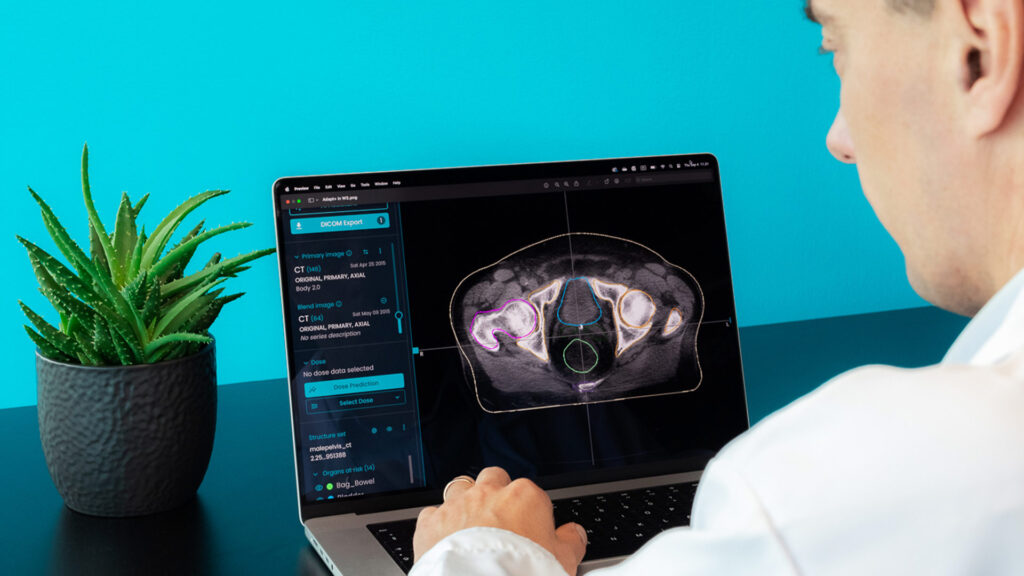Overview
St. Luke’s Radiation Oncology Network (SLRON) is Ireland’s largest radiotherapy provider and one of the largest centres in Europe. It treats over 5,500 patients each year across three sites in Dublin. Faced with increasing patient complexity, time pressures, and a need for consistent care delivery, SLRON embarked on an AI implementation strategy. The goal was not just to improve workflows, but to reshape how clinicians learn, adapt, and deliver care.
This case study explores how SLRON implemented MVision AI’s GBS™ solution, bringing about measurable efficiency gains and significant quality improvements across both clinical practice and registrar training.
Key Challenges
In recent years, SLRON has faced several interrelated challenges:
- Increased case complexity resulting in rising contouring times for complex sites such as head and neck or thorax.
- A growing need for radiotherapy for cancer treatment leading to increased patient volumes.
- Fixed CT-to-treatment schedules linked to KPIs, which limited the ability to translate contouring time savings into earlier treatment starts.
- High staff workloads resulting in limited opportunities for regular in-person registrar workshops.
- Staff working across different sites within the network, creating a need to ensure consistency.
SLRON needed a solution that supported the clinical workflow and tackled the problem of increased contouring task times – all while ensuring consistency and maintaining the high standards required for precision radiotherapy.
Study
Supported by the Friends of St. Luke’s charitable body, SLRON acquired MVision AI’s GBS™ solution and implemented it across all patient cohorts in a single coordinated launch across their network. GBS™ consists of three AI-powered tools: Contour+, an AI-powered auto-contouring software; Guide, a guideline training environment and Verify, a contour assessment tool.
SLRON’s clinical setup included a diverse mix of treatment technologies (Varian TrueBeams, Elekta Trilogies, and Varian Clinacs) along with multiple planning systems (Eclipse, Monaco, and OMP). While this created technical complexity, it also provided a strong testing ground for the flexibility and robustness of AI tools.
Main Findings
After implementing Contour+, SLRON analyzed four years of historical data from their clinical system and compared it to performance data from the first year using AI. The impact was significant. During the four years prior to AI adoption, contouring times had steadily increased, driven by rising patient volumes and case complexity. Following the introduction of Contour+, that trend reversed noticeably. Task turnaround times began to decline consistently, with no signs yet of leveling off.

As Ciaran Malone, Senior Medical Physicist/Research Fellow at St. Luke’s Radiation Oncology Network, shared in a recent interview: “In real-world practice, we saw up to 70% time savings for head and neck, abdomen, and thoracic cases. The real-world results matched or even exceeded what manual timing studies have previously reported. We were delighted, especially considering the added complexities of the real clinical environment with frequent interruptions and constant multi-tasking.”
With Contour+ in place, treatment plans were, on average, ready 9.7 working hours sooner across all clinical patient groups — around 10% faster than targeted workflow KPIs. Furthermore, 8% more treatment plans were ready at least two working days earlier compared to the period before Contour+ was implemented. A significantly larger share of plans were ready for treatment as much as five days ahead of the scheduled treatment start date. When scaled to their patient population, this translated to approximately 200 patients each year who could potentially begin treatment earlier. These time savings gave the SLRON team greater flexibility to adjust workflows and thereby streamline patient treatment.
The introduction of Contour+ also brought greater flexibility to the clinical day. Because clinicians spent less time on contouring, they could complete multiple cases within time slots that previously only allowed for one. Contour+ proved especially valuable for complex cases — such as those involving the head and neck — which often experienced delays due to their intensive time requirements. With AI-driven auto-segmentation, these high-demand cases now move through the workflow more efficiently.
One additional advantage has been the ability to customize AI-generated structures using advanced operations. With consultants across three sites, SLRON needed a way to align contours with local clinical preferences. Advanced operations allowed the team to fine-tune structures—such as lymph nodes—by automatically trimming, extending, or adjusting contours as needed. This meant clinicians started from a much closer baseline, reducing editing time and increasing consistency.
Contour+ also helped narrow the experience gap between junior and senior staff members, a major step toward harmonising clinical practice across their multi-clinic environment.
Guide and Verify for Training and Quality Assurance
Alongside Contour+, SLRON introduced Verify and Guide. The team has used Verify as a quality assurance tool for registrar training. Guide is currently being integrated into registrar training and allows trainees to exercise contouring on their own schedule and benchmark their work against expert consensus structures. This asynchronous model enables consultants to use in-person workshops more effectively, focusing on nuanced feedback rather than repetitive instruction.
SLRON is moving away from an episodic training approach toward a more continuous one, allowing registrars to refine their skills between formal sessions.
Conclusion
SLRON’s experience shows that successful AI adoption requires more than installing new software. It demands clinical oversight, thoughtful integration into existing systems, and continued investment in training and education.
Professor Pierre Thirion, Radiation Oncologist at SLRON, spoke to this shift in an interview about the role of AI in clinical practice: “AI in RT brings changes to our practice and a complete rethinking of the way we work. It has a learning curve and pushes us out of our comfort zone. Overall, it means more than speeding up the process. It is a new approach.”
Through the implementation of MVision Contour+, Guide, and Verify, SLRON has demonstrated how AI can enhance internal workflow efficiency, support staff development, and lay the groundwork for future innovations in adaptive planning and radiotherapy research. By working with the structure of existing clinical systems, rather than against them, SLRON offers a model for responsible and impactful AI integration.













